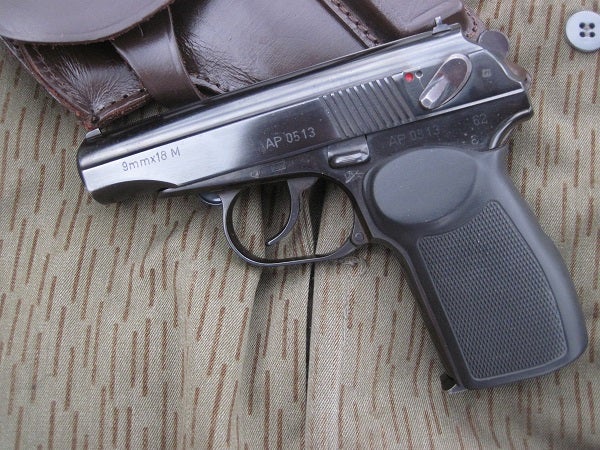The East German Makarov Pistol – A Relic of the Cold War You Can Shoot
Rob Reed 11.11.14

The fall of the Berlin Wall, 25 years ago this week, is one of the symbolic milestones leading to the end of the Cold War.
The wall was built in 1961 to keep citizens of Communist East Germany (the “German Democratic Republic” or “DDR”) from fleeing to freedom into West Germany (“The Federal Republic of Germany”).
For 28 years the wall divided East Berlin and West Berlin, cutting neighborhoods and sometimes families in half. It was a manifest symbol of Communist dominion over Eastern Europe and was a frequent flashpoint for tension between the United States and the Soviet Union. Over 200 people are estimated to have been killed while trying to cross the border. In 1987 President Ronald Reagan famously urged, “Mr. Gorbachav, tear down this wall!” in a speech in the wall’s shadow.
On November 9, 1989, the government of East Germany, facing large internal protests, announced that East Germans were now free to travel to West Germany. Although the announcement was partially in error, as East Germany merely intended to broaden the categories of those who would be granted permission to cross the border, the live television statement caused thousands of Easter Berliners to immediately head towards the border checkpoints to cross into West Berlin. The border guards, overwhelmed and lacking orders from their superiors, essentially threw open the border.
That night thousands of Berliners, from both the East and West, joyfully celebrated. The first pieces of the wall fell that night to the pick axes and sledgehammers of the crowd and by October East and West Germany were reunited. The Soviet Union itself fell in December 1991.
With the dissolution of the Warsaw Pact, a large amount of former “enemy” firearms and equipment wound up for sale on the open market in the 1990’s. While full-auto firearms, such as the AKM, could not legally be imported, AK parts kits, uniforms, gear, and handguns could be imported.
One of the most interesting of those handguns, the Makarov, was relatively unknown in the West prior to the fall of the “Evil Empire.” The few examples in the U.S. were strictly high-priced collector’s items, and the Mak’s distinctive 9x18mm ammo was also scarce and expensive.
The Makarov pistol was adopted by the Soviet Union in 1951 to replace the World War II-era TT-33 Tokarev pistol and Czar-era Nagant M1895 revolver. The Makarov is a straight blowback pistol that is essentially a simplification of the Walther PP pistol design. It has a fixed barrel, a traditional DA/SA trigger mechanism, an exposed hammer, and a slide-mounted decocker. The magazines hold 8 rounds of 9x18mm ammunition. The 9x18mm military cartridge fires a 93 gr FMJ bullet at about 1050 FPS.
The Soviet Union licensed production to several countries, including East Germany, and the East Germans were producing pistols for their domestic use by the late 1950’s. These pistols served as police, border guard, and military sidearms throughout the life of the DDR. In fact, some pistols were retained and issued by the newly reconstituted German state until they could be replaced by more modern pistols.
With the fall of the Berlin Wall, and the reunification of Germany, many thousands of former East German Makarov pistols were imported to the United States. At one point they could be purchased for as little as $99. In addition many hundreds of thousands of round of surplus 9x18mm ammo were imported. The low price of the pistol and ammo, along with its historic significance, made picking up a East German Makarov a “no brainer” for many shooters in the 90’s.
The pistol pictured here was manufactured in East Germany in 1962. It is shown with the appropriate holster on an East German Rain Camouflage parka. The markings show this particular pistol was used both by the East German government and was later reissued by the combined Federal Republic of Germany.
The markings show this particular pistol was used both by the East German government and was later reissued by the combined Federal Republic of Germany. I purchased this pistol in the late 90’s. It was equipped with a set of thumb rest “target grips” to meet import requirements. I replaced those with the rubber Pearce Grips seen in the photo and also acquired a set of actual hard plastic East German grips later (which I couldn’t find for the photo.) In use I’ve found this pistol to be both reliable and accurate. The double-action trigger pull, while heavy, has smoothed out noticeably with use.
What once was a symbol of a totalitarian state has become the spoils of our victory in the Cold War. It’s like owning a piece of the Berlin Wall that I can shoot.